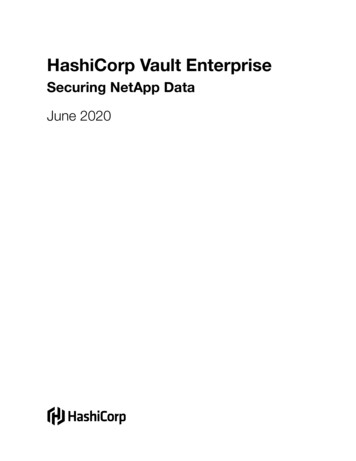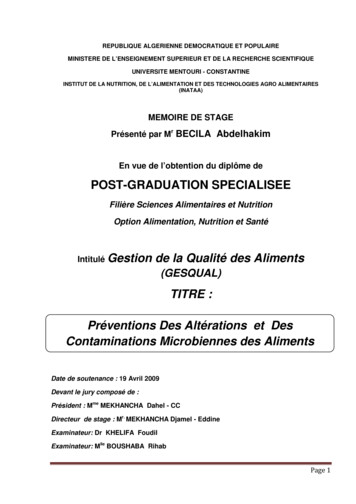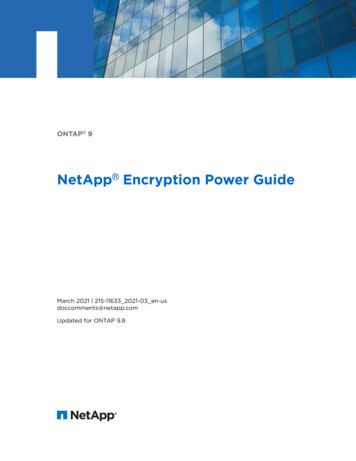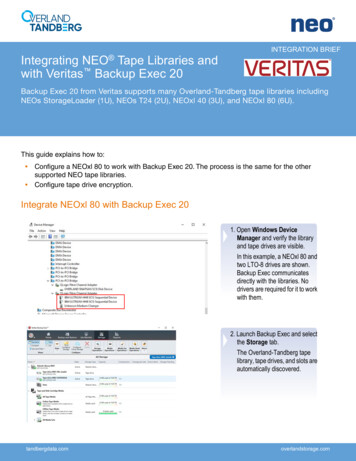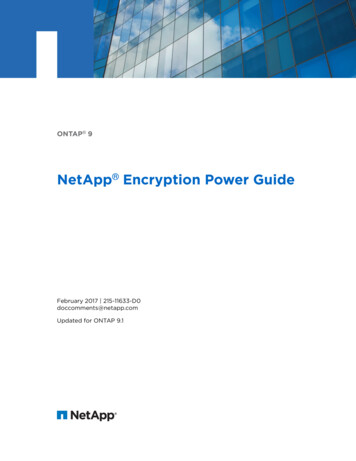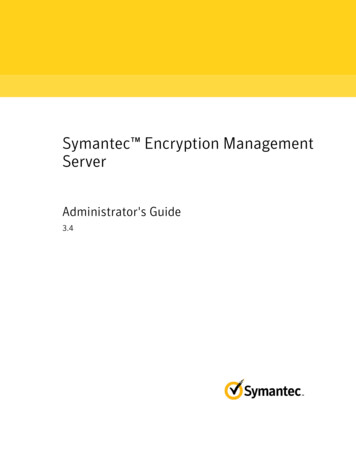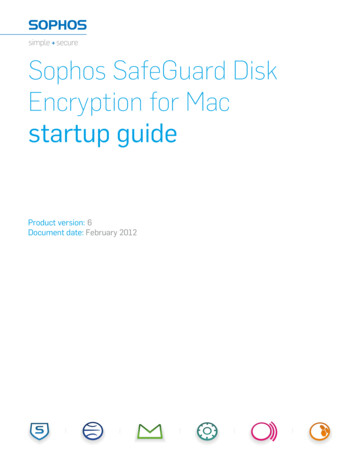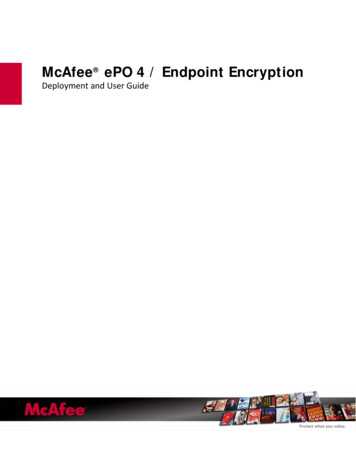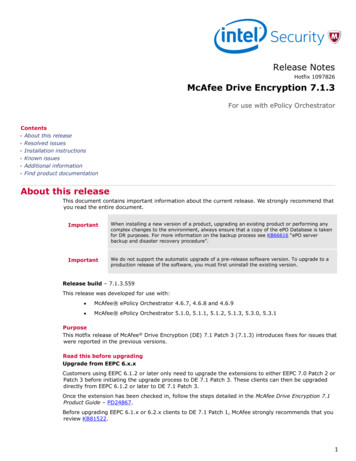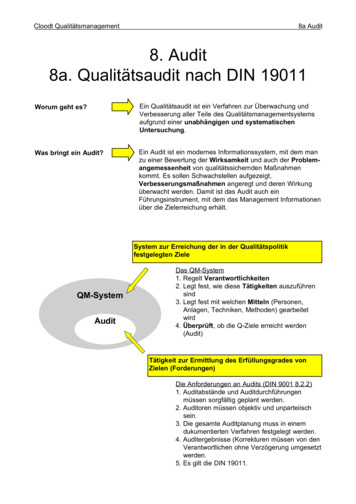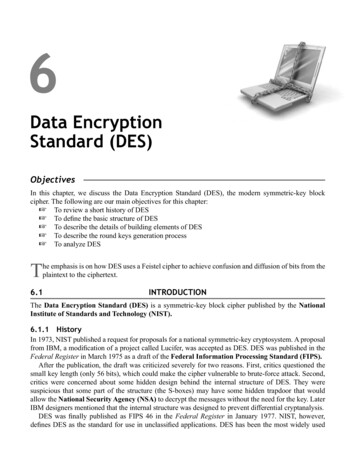
Transcription
6Data EncryptionStandard (DES)ObjectivesIn this chapter, we discuss the Data Encryption Standard (DES), the modern symmetric-key blockcipher. The following are our main objectives for this chapter: To review a short history of DES To define the basic structure of DES To describe the details of building elements of DES To describe the round keys generation process To analyze DESThe emphasis is on how DES uses a Feistel cipher to achieve confusion and diffusion of bits from theplaintext to the ciphertext.6.1INTRODUCTIONThe Data Encryption Standard (DES) is a symmetric-key block cipher published by the NationalInstitute of Standards and Technology (NIST).6.1.1 HistoryIn 1973, NIST published a request for proposals for a national symmetric-key cryptosystem. A proposalfrom IBM, a modification of a project called Lucifer, was accepted as DES. DES was published in theFederal Register in March 1975 as a draft of the Federal Information Processing Standard (FIPS).After the publication, the draft was criticized severely for two reasons. First, critics questioned thesmall key length (only 56 bits), which could make the cipher vulnerable to brute-force attack. Second,critics were concerned about some hidden design behind the internal structure of DES. They weresuspicious that some part of the structure (the S-boxes) may have some hidden trapdoor that wouldallow the National Security Agency (NSA) to decrypt the messages without the need for the key. LaterIBM designers mentioned that the internal structure was designed to prevent differential cryptanalysis.DES was finally published as FIPS 46 in the Federal Register in January 1977. NIST, however,defines DES as the standard for use in unclassified applications. DES has been the most widely used
144Cryptography and Network Securitysymmetric-key block cipher since its publication. NIST later issued a new standard (FIPS 46-3) thatrecommends the use of triple DES (repeated DES cipher three times) for future applications. As we willsee in Chapter 7, AES, the recent standard, is supposed to replace DES in the long run.6.1.2 OverviewDES is a block cipher, as shown in Fig. 6.1.64-bit plaintextDEScipherDESreverse cipher56-bit key64-bit ciphertextFig. 6.1DecryptionEncryption64-bit plaintext64-bit ciphertextEncryption and decryption with DESAt the encryption site, DES takes a 64-bit plaintext and creates a 64-bit ciphertext; at the decryptionsite, DES takes a 64-bit ciphertext and creates a 64-bit block of plaintext. The same 56-bit cipher key isused for both encryption and decryption.6.2DES STRUCTURELet us concentrate on encryption; later we will discuss decryption. The encryption process is made oftwo permutations (P-boxes), which we call initial and final permutations, and sixteen Feistel rounds.Each round uses a different 48-bit round key generated from the cipher key according to a predefinedalgorithm described later in the chapter. Figure 6.2 shows the elements of DES cipher at the encryptionsite.64-bit plaintextDESInitial permutationRound 2Round 16K148-bitK248-bitK16Round-key generatorRound 156-bit cipher key48-bitFinal permutation64-bit ciphertextFig. 6.2General structure of DES
Data Encryption Standard (DES) 1456.2.1 Initial and Final PermutationsFigure 6.3 shows the initial and final permutations (P-boxes). Each of these permutations takes a 64-bitinput and permutes them according to a predefined rule. We have shown only a few input ports and thecorresponding output ports. These permutations are keyless straight permutations that are the inverse ofeach other. For example, in the initial permutation, the 58th bit in the input becomes the first bit in theoutput. Similarly, in the final permutation, the first bit in the input becomes the 58th bit in the output. Inother words, if the rounds between these two permutations do not exist, the 58th bit entering the initialpermutation is the same as the 58th bit leaving the final 6440586416 Rounds12825FinalPermutation12825405864Fig. 6.3 Initial and final permutation steps in DESThe permutation rules for these P-boxes are shown in Table 6.1. Each side of the table can be thoughtof as a 64-element array. Note that, as with any permutation table we have discussed so far, the valueof each element defines the input port number, and the order (index) of the element defines the outputport number.Table 6.1Initial and final permutation tablesInitial PermutationFinal Permutation58 50 42 34 26 18 10 0260 52 44 36 28 20 12 0462 54 46 38 30 22 14 0664 56 48 40 32 24 16 0857 49 41 33 25 17 09 0159 51 43 35 27 19 11 0361 53 45 37 29 21 13 0563 55 47 39 31 23 15 0740 08 48 16 56 24 64 3239 07 47 15 55 23 63 3138 06 46 14 54 22 62 3037 05 45 13 53 21 61 2936 04 44 12 52 20 60 2835 03 43 11 51 19 59 2734 02 42 10 50 18 58 2633 01 41 09 49 17 57 25These two permutations have no cryptography significance in DES. Both permutations are keylessand predetermined. The reason they are included in DES is not clear and has not been revealed by theDES designers. The guess is that DES was designed to be implemented in hardware (on chips) and thatthese two complex permutations may thwart a software simulation of the mechanism.
146Cryptography and Network SecurityExample 6.1Find the output of the initial permutation box when the input is given in hexadecimalas:0x0002 0000 0000 0001Solution The input has only two 1s (bit 15 and bit 64); the output must also have only two 1s (thenature of straight permutation). Using Table 6.1, we can find the output related to these two bits. Bit 15in the input becomes bit 63 in the output. Bit 64 in the input becomes bit 25 in the output. So the outputhas only two 1s, bit 25 and bit 63. The result in hexadecimal is0x0000 0080 0000 0002Example 6.2Prove that the initial and final permutations are the inverse of each other by findingthe output of the final permutation if the input is0x0000 0080 0000 0002Solution Only bit 25 and bit 64 are 1s; the other bits are 0s. In the final permutation, bit 25 becomesbit 64 and bit 63 becomes bit 15. The result0x0002 0000 0000 0001The initial and final permutations are straight D-boxes that are inverses of each other andhence are permutations. They have no cryptography significance in DES.6.2.2 RoundsDES uses 16 rounds. Each round of DES is a Feistel cipher, as shown in Fig. 6.4.Mixer32 bitsRI–1f ( RI–1, KI )KISwapperRound32 bitsLI–1LIRI32 bits32 bitsFig. 6.4 A round in DES (encryption site)The round takes LI 1 and RI 1 from previous round (or the initial permutation box) and creates LI andRI, which go to the next round (or final permutation box). As we discussed in Chapter 5, we can assumethat each round has two cipher elements (mixer and swapper). Each of these elements is invertible.The swapper is obviously invertible. It swaps the left half of the text with the right half. The mixer isinvertible because of the XOR operation. All noninvertible elements are collected inside the functionf (RI 1, KI).
Data Encryption Standard (DES) 147DES FunctionThe heart of DES is the DES function. The DESfunction applies a 48-bit key to the rightmost 32 bits(RI 1) to produce a 32-bit output. This function ismade up of four sections: an expansion D-box, awhitener (that adds key), a group of S-boxes, and astraight D-box as shown in Fig. 6.5.In32 bitsExpansion D-box48 bitsKI (48 bits)XORf ( RI–1, KI )48 bitsS-BoxesS S S S S S S SExpansion D-box Since RI 1 is a 32-bit input and32 bitsKI is a 48-bit key, we first need to expand RI 1 toStraight D-box48 bits. RI 1 is divided into 8 4-bit sections. Each 4-bitsection is then expanded to 6 bits. This expansion32 bitspermutation follows a predetermined rule. For eachOutsection, input bits 1, 2, 3, and 4 are copied to outputbits 2, 3, 4, and 5, respectively. Output bit 1 comesFig. 6.5 DES functionfrom bit 4 of the previous section; output bit 6 comesfrom bit 1 of the next section. If sections 1 and 8 can be considered adjacent sections, the same rule applies to bits 1 and 32. Fig. 6.6 shows the input and output in the expansion permutation.From bit 32From bit 132-bit input48-bit outputFig. 6.6Expansion permutationAlthough the relationship between the input and output can be defined mathematically, DES usesTable 6.2 to define this D-box. Note that the number of output ports is 48, but the value range is only1 to 32. Some of the inputs go to more than one output. For example, the value of input bit 5 becomesthe value of output bits 6 and 8.Table 6.2Expansion D-box 1Whitener (XOR) After the expansion permutation, DES uses the XOR operation on the expandedright section and the round key. Note that both the right section and the key are 48-bits in length. Alsonote that the round key is used only in this operation.
148Cryptography and Network SecurityS-Boxes The S-boxes do the real mixing (confusion). DES uses 8 S-boxes, each with a 6-bit input anda 4-bit output. See Fig. 6.7.48-bit inputArray of bit outputFig. 6.7 S-boxesThe 48-bit data from the second operation is dividedinto eight 6-bit chunks, and each chunk is fed into a box.The result of each box is a 4-bit chunk; when these arecombined the result is a 32-bit text. The substitution in eachbox follows a pre-determined rule based on a 4-row by 16column table. The combination of bits 1 and 6 of the inputdefines one of four rows; the combination of bits 2 through5 defines one of the sixteen columns as shown in Fig. 6.8.This will become clear in the examples.Because each S-box has its own table, we need eighttables, as shown in Tables 6.3 to 6.10, to define the outputof these boxes. The values of the inputs (row number andcolumn number) and the values of the outputs are given asdecimal numbers to save space. These need to be changedto binary.Table 6.3bit 1 bit 2 bit 3 bit 4 bit 5 bit 601 2 3012315TableentryS-boxbit 1 bit 2 bit 3Fig. 6.8bit 4S-box ruleS-box 00613Table 6.4 S-box 51409
Data Encryption Standard (DES) 149Table 6.5S-box 50212123456789101112131415Table 6.6 S-box ble 6.7 S-box 112131415Table 6.8 S-box 06304030212090515101114010710000813Table 6.9 S-box 3126789101112131415Table 6.10 S-box 03050830201140704108131512090903050611
150Cryptography and Network SecurityExample 6.3The input to S-box 1 is 100011. What is the output?Solution If we write the first and the sixth bits together, we get 11 in binary, which is 3 in decimal.The remaining bits are 0001 in binary, which is 1 in decimal. We look for the value in row 3, column 1,in Table 6.3 (S-box 1). The result is 12 in decimal, which in binary is 1100. So the input 100011 yieldsthe output 1100.Example 6.4The input to S-box 8 is 000000. What is the output?Solution If we write the first and the sixth bits together, we get 00 in binary, which is 0 in decimal.The remaining bits are 0000 in binary, which is 0 in decimal. We look for the value in row 0, column 0,in Table 6.10 (S-box 8). The result is 13 in decimal, which is 1101 in binary. So the input 000000 yieldsthe output 1101.Final Permutation The last operation in the DES function is a permutation with a 32-bit input anda 32-bit output. The input/output relationship for this operation is shown in Table 6.11 and follows thesame general rule as previous tables. For example, the seventh bit of the input becomes the second bitof the output.Table 6.11Straight permutation 30919133006221104256.2.3 Cipher and Reverse CipherUsing mixers and swappers, we can create the cipher and reverse cipher, each having 16 rounds. Thecipher is used at the encryption site; the reverse cipher is used at the decryption site. The whole idea isto make the cipher and the reverse cipher algorithms similar.First Approach To achieve this goal, one approach is to make the last round (round 16) differentfrom the others; it has only a mixer and no swapper. This is done in Figure 6.9.Although the rounds are not aligned, the elements (mixer or swapper) are aligned. We proved inChapter 5 that a mixer is a self-inverse; so is a swapper. The final and initial permutations are alsoinverses of each other. The left section of the plaintext at the encryption site, L0, is enciphered as L16 atthe encryption site; L16 at the decryption is deciphered as L0 at the decryption site. The situation is thesame with R0 and R16.A very important point we need to remember about the ciphers is that the round keys (K1 to K16)should be applied in the reverse order. At the encryption site, round 1 uses K1 and round 16 uses K16; atthe decryption site, round 1 uses K16 and round 16 uses K1.In the first approach, there is no swapper in the last round.
Data Encryption Standard (DES) 15164-bit plaintext64-bit plaintextInitial permutationFinal permutationL0R0K1ffK2ffK15ffK16fL16R16Final permutation64-bit ciphertextRound 2Round 1Round 16Round 15EncryptionDecryptionRound 2Round 1fRound 16R0Round 15L0R16L16Initial permutation64-bit ciphertextFig. 6.9 DES cipher and reverse cipher for the first approachAlgorithmAlgorithm 6.1 gives the pseudocode for the cipher and four corresponding routines in the first approach.The codes for the rest of the routines are left as exercises.
152Cryptography and Network SecurityAlgorithm 6.1Pseudocode for DES cipherCipher (plainBlock[64], RoundKeys[16, 48], cipherBlock[64]){permute (64, 64, plainBlock, inBlock, InitialPermutationTable)split (64, 32, inBlock, leftBlock, rightBlock)for (round 1 to 16){mixer (leftBlock, rightBlock, RoundKeys[round])if (round! 16) swapper (leftBlock, rightBlock)}combine (32, 64, leftBlock, rightBlock, outBlock)permute (64, 64, outBlock, cipherBlock, FinalPermutationTable)}mixer (leftBlock[48], rightBlock[48], RoundKey[48]){copy (32, rightBlock, T1)function (T1, RoundKey, T2)exclusiveOr (32, leftBlock, T2, T3)copy (32, T3, rightBlock)}swapper (leftBlock[32], rigthBlock[32]){copy (32, leftBlock, T)copy (32, rightBlock, leftBlock)copy (32, T, rightBlock)}function (inBlock[32], RoundKey[48], outBlock[32]){permute (32, 48, inBlock, T1, ExpansionPermutationTable)exclusiveOr (48, T1, RoundKey, T2)substitute (T2, T3, SubstituteTables)permute (32, 32, T3, outBlock, StraightPermutationTable)}substitute (inBlock[32], outBlock[48], SubstitutionTables[8, 4, 16]){for (i 1 to 8){row 2 inBlock[i 6 1] inBlock [i 6 6]col 8 inBlock[i 6 2] 4 inBlock[i 6 3] 2 inBlock[i 6 4] inBlock[i 6 5]value SubstitutionTables [i][row][col]outBlock[[i 4 1] value / 8; value value mod 8outBlock[[i 4 2] value / 4; value value mod 4outBlock[[i 4 3] value / 2; value value mod 2outBlock[[i 4 4] value}}
Data Encryption Standard (DES) 153Alternative Approach In the first approach, round 16 is different from other rounds; there is noswapper in this round. This is needed to make the last mixer in the cipher and the first mixer in the reverse cipher aligned. We can make all 16 rounds the same by including one swapper to the 16th roundand add an extra swapper after that (two swappers cancel the effect of each other). We leave the designfor this approach as an exercise.Key Generation The round-key generator creates sixteen 48-bit keys out of a 56-bit cipher key.However, the cipher key is normally given as a 64-bit key in which 8 extra bits are the parity bits, whichare dropped before the actual key-generation process, as shown in Fig. 6.10.Key withparity bits(64 bits)Parity dropCipher key (56 bits)28 bits28 bitsShift leftShift left28 bitsRound key 128 bitsCompressionD-box48 bitsShift leftShift left28 bitsRound key 228 bitsCompressionD-box48 bitsShift leftShift left28 bitsRound key 1648 bitsFig. 6.10Round-Key GeneratorShiftingRoundsShift1, 2, 9, 16 one bitOtherstwo bits28 bitsCompressionD-boxKey generationParity Drop The preprocess before key expansion is a compression transposition step that we callparity bit drop. It drops the parity bits (bits 8, 16, 24, 32, , 64) from the 64-bit key and permutes therest of the bits according to Table 6.12. The remaining 56-bit value is the actual cipher key which is usedto generate round keys. The parity drop step (a compression D-box) is shown in Table 6.12.
154Cryptography and Network SecurityTable 6.12Parity-bit drop 72921130528201204Shift Left After the straight permutation, the key is divided into two 28-bit parts. Each part is shiftedleft (circular shift) one or two bits. In rounds 1, 2, 9, and 16, shifting is one bit; in the other rounds, it istwo bits. The two parts are then combined to form a 56-bit part. Table 6.13 shows the number of shiftsfor each round.Table 6.13Number of bit shiftsRound12345678910111213141516Bit shifts1122222212222221Compression D-box The compression D-box changes the 58 bits to 48 bits, which are used as akey for a round. The compression step is shown in Table 6.14.Table 6.14Key-compression 2Algorithm Let us write a simple algorithm to create round keys from the key with parity bits.Algorithm 6.2 uses several routines from Algorithm 6.1. The new one is the shiftLeft routine, for whichthe code is given.Algorithm 6.2Algorithm for round-keys generationKey Generator (keyWithParities[64], RoundKeys[16, 48], ShiftTable[16]){permute (64, 56, keyWithParities, cipherKey, ParityDropTable)split (56, 28, cipherKey, leftKey, rightKey)for (round 1 to 16){shiftLeft (leftKey, ShiftTable[round])shiftLeft (rightKey, ShiftTable[round])
Data Encryption Standard (DES) 155Algorithm 6.2(Contd.)combine (28, 56, leftKey, rightKey, preRoundKey)permute (56, 48, preRoundKey, RoundKeys[round], KeyCompressionTable)}}shiftLeft (block[28], numOfShifts){for (i 1 to numOfShifts){T block[1]for (j 2 to 28){block [j 1] block [j]}block[28] T}}6.2.4 ExamplesBefore analyzing DES, let us look at some examples to see the how encryption and decryption changethe value of bits in each round.Example 6.5We choose a random plaintext block and a random key, and determine what theciphertext block would be (all in hexadecimal):Plaintext: 123456ABCD132536Key: AABB09182736CCDDCipherText: C0B7A8D05F3A829CLet us show the result of each round and the text created before and after the rounds. Table 6.15 firstshows the result of steps before starting the round.Table 6.15Trace of data for Example 6.5Plaintext: 123456ABCD132536After initial permutation:14A7D67818CA18ADAfter splitting: L0 14A7D678 R0 18CA18ADLeftRightRound KeyRound 1Round18CA18AD5A78E394194CD072DE8CRound 25A78E3944A1210F64568581ABCCERound 34A1210F6B808959106EDA4ACF5B5Round 4B8089591236779C2DA2D032B6EE3Round 5236779C2A15A4B8769A629FEC913Round 6A15A4B872E8F9C65C1948E87475ERound 72E8F9C65A9FC20A3708AD2DDB3C0Round 8A9FC20A3308BEE9734F822F0C66DRound 9308BEE9710AF9D3784BB4473DCCC
156Cryptography and Network SecurityTable 6.15(Contd.)Round 1010AF9D376CA6CB2002765708B5BFRound 116CA6CB20FF3C485F6D5560AF7CA5Round 12FF3C485F22A5963BC2C1E96A4BF3Round 1322A5963B387CCDAA99C31397C91FRound 14387CCDAABD2DD2AB251B8BC717D0Round 15BD2DD2ABCF26B4723330C5D9A36DRound 1619BA9212CF26B472181C5D75C66DAfter combination: 19BA9212CF26B472(after final permutation)Ciphertext: C0B7A8D05F3A829CThe plaintext goes through the initial permutation to create completely different 64 bits (16hexadecimal digit). After this step, the text is split into two halves, which we call L0 and R0. The tableshows the result of 16 rounds that involve mixing and swapping (except for the last round). The resultsof the last rounds (L16 and R16) are combined. Finally the text goes through final permutation to createthe ciphertext.Some points are worth mentioning here. First, the right section out of each round is the same as the leftsection out of the next round. The reason is that the right section goes through the mixer without change,but the swapper moves it to the left section. For example, R1 passes through the mixer of the second roundwithout change, but then it becomes L2 because of the swapper. The interesting point is that we do not havea swapper at the last round. That is why R15 becomes R16 instead of becoming L16.Example 6.6Let us see how Bob, at the destination, can decipher the ciphertext received fromAlice using the same key. We have shown only a few rounds to save space. Table 6.16 shows someinteresting points. First, the round keys should be used in the reverse order. Compare Table 6.15 andTable 6.16. The round key for round 1 is the same as the round key for round 16. The values of L0 andR0 during decryption are the same as the values of L16 and R16 during encryption. This is the same withother rounds. This proves not only that the cipher and the reverse cipher are inverses of each other in thewhole, but also that each round in the cipher has a corresponding reverse round in the reverse cipher.The result proves that the initial and final permutation steps are also inverses of each other.Table 6.16Trace of data for Example 6.6Ciphertext: C0B7A8D05F3A829CAfter initial permutation: 19BA9212CF26B472After splitting: L0 19BA9212 R0 CF26B472RoundLeftRightRound KeyRound 1CF26B472BD2DD2AB181C5D75C66DRound 2BD2DD2AB387CCDAA3330C5D9A36D.Round 155A78E39418CA18AD4568581ABCCERound 1614A7D67818CA18AD194CD072DE8CAfter combination: 14A7D67818CA18ADPlaintext:123456ABCD132536(after final permutation)
Data Encryption Standard (DES) 1576.3DES ANALYSISCritics have used a strong magnifier to analyze DES. Tests have been done to measure the strength ofsome desired properties in a block cipher. The elements of DES have gone through scrutinies to see ifthey have met the established criteria. We discuss some of these in this section.6.3.1 PropertiesTwo desired properties of a block cipher are the avalanche effect and the completeness.Avalanche Effect Avalanche effect means a small change in the plaintext (or key) should create asignificant change in the ciphertext. DES has been proved to be strong with regard to this property.Example 6.7To check the avalanche effect in DES, let us encrypt two plaintext blocks (with thesame key) that differ only in one bit and observe the differences in the number of bits in each round.Plaintext: 0000000000000000Ciphertext: 4789FD476E82A5F1Key: 22234512987ABB23Plaintext: 0000000000000001Ciphertext: 0A4ED5C15A63FEA3Key: 22234512987ABB23Although the two plaintext blocks differ only in the rightmost bit, the ciphertext blocks differ in 29 bits.This means that changing approximately 1.5 percent of the plaintext creates a change of approximately45 percent in the ciphertext. Table 6.17 shows the change in each round. It shows that significantchanges occur as early as the third round.Table 6.17Number of bit differences for Example 6.7Rounds12345678910111213141516Bit ess Effect Completeness effect means that each bit of the ciphertext needs to dependon many bits on the plaintext. The diffusion and confusion produced by D-boxes and S-boxes in DES,show a very strong completeness effect.6.3.2 Design CriteriaThe design of DES was revealed by IBM in 1994. Many tests on DES have proved that it satisfies someof the required criteria as claimed. We briefly discuss some of these design issues.S-Boxes We have discussed the general design criteria for S-boxes in Chapter 5; we only discussthe criteria selected for DES here. The design provides confusion and diffusion of bits from each roundto the next. According to this revelation and some research, we can mention several properties ofS-boxes.1. The entries of each row are permutations of values between 0 and 15.2. S-boxes are nonlinear. In other words, the output is not an affine transformation of the input.See Chapter 5 for discussion on the linearity of S-boxes.3. If we change a single bit in the input, two or more bits will be changed in the output.
158Cryptography and Network Security4.5.6.7.8.If two inputs to an S-box differ only in two middle bits (bits 3 and 4), the output must differ inat least two bits. In other words, S(x) and S(x 001100) must differ in at least two bits wherex is the input and S(x) is the output.If two inputs to an S-box differ in the first two bits (bits 1 and 2) and are the same in the last twobits (5 and 6), the two outputs must be different. In other words, we need to have the followingrelation S(x) S(x 11bc00), in which b and c are arbitrary bits.There are only 32 6-bit input-word pairs (xi and xj), in which xi xj (000000)2. These 32 inputpairs create 32 4-bit output-word pairs. If we create the difference between the 32 output pairs,d yi yj, no more than 8 of these d’s should be the same.A criterion similar to # 6 is applied to three S-boxes.In any S-box, if a single input bit is held constant (0 or 1) and the other bits are changedrandomly, the differences between the number of 0s and 1s are minimized.D-BoxesBetween two rows of S-boxes (in two subsequent rounds), there are one straight D-box (32 to 32)and one expansion D-box (32 to 48). These two D-boxes together provide diffusion of bits. We havediscussed the general design principle of D-boxes in Chapter 5. Here we discuss only the ones appliedto the D-boxes used inside the DES function. The following criteria were implemented in the design ofD-boxes to achieve this goal:1. Each S-box input comes from the output of a different S-box (in the previous round).2. No input to a given S-box comes from the output from the same box (in the previous round).3. The four outputs from each S-box go to six different S-boxes (in the next round).4. No two output bits from an S-box go to the same S-box (in the next round).5. If we number the eight S-boxes, S1, S2, , S8,a. An output of Sj 2 goes to one of the first two bits of Sj (in the next round).b. An output bit from Sj 1 goes to one of the last two bits of Sj (in the next round).c. An output of Sj 1 goes to one of the two middle bits of Sj (in the next round).6. For each S-box, the two output bits go to the first or last two bits of an S-box in the next round.The other two output bits go to the middle bits of an S-box in the next round.7. If an output bit from Sj goes to one of the middle bits in Sk (in the next round), then an outputbit from Sk cannot go to the middle bit of Sj. If we let j k, this implies that none of the middlebits of an S-box can go to one of the middle bits of the same S-box in the next round.Number of Rounds DES uses sixteen rounds of Feistel ciphers. It has been proved that after eightrounds, each ciphertext is a function of every plaintext bit and every key bit; the ciphertext is thoroughlya random function of plaintext and ciphertext. Therefore, it looks like eight rounds should be enough.However, experiments have found that DES versions with less than sixteen rounds are even more vulnerable to known-plaintext attacks than brute-force attack, which justifies the use of sixteen rounds bythe designers of DES.6.3.3 DES WeaknessesDuring the last few years critics have found some weaknesses in DES.Weaknesses in Cipher DesignWe will briefly mention some weaknesses that have been found in the design of the cipher.
Data Encryption Standard (DES) 159S-boxes At least three weaknesses are mentioned in the literature for S-boxes.1. In S-box 4, the last three output bits can be derived in the same way as the first output bit bycomplementing some of the input bits.2. Two specifically chosen inputs to an S-box array can create the same output.3. It is possible to obtain the same output in a single round by changing bits in only three neighboringS-boxes.D-boxes One mystery and one weakness were found in the design of D-boxes:1. It is not clear why the designers of DES used the initial and final permutations; these have nosecurity benefits.2. In the expansion permutation (inside the function), the first and fourth bits of every 4-bit seriesare repeated.Weakness in the Cipher KeySeveral weaknesses have been found in the cipher key.Key Size Critics believe that the most serious weakness of DES is in its key size (56 bits). To do abrute-force attack on a given ciphertext block, the adversary needs to check 256 keys.a. With available technology, it is possible to check one million keys per second. This means thatwe need more than two thousand years to do brute-force attacks on DES using only a computerwith one processor.b. If we can make a computer with one million chips (parallel processing), then we can test thewhole key domain in approximately 20 hours. When DES was introduced, the cost of such acomputer was over several million dollars, but the cost has dropped rapidly. A special computerwas built in 1998 that found the key in 112 hours.c. Computer networks can simulate
Straight D-box Expansion D-box S-Boxes XOR 32 bits In 48 bits 32 bits 32 bits Fig. 6.5 DES function The heart of DES is the DES function. The DES function applies a 48-bit key to the rightmost 32 bits (R I 1) to produce a 32-bit output. This function is made up of four sections: an expa
